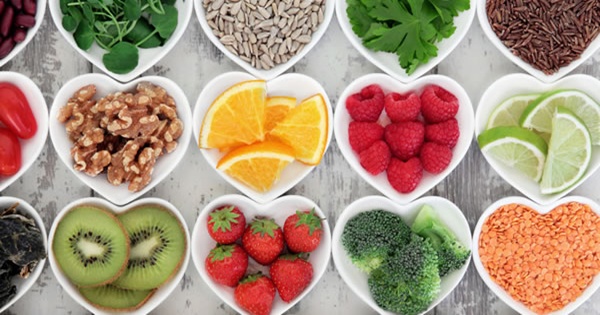Top 10 Diabetic Super Foods

Not all healthy foods are created equal. Greens may be good for you, besides nutrient content, the glycemic index (GI) of a food may also help you make healthy choices. The GI measures how quickly a food will raise blood sugar. Low GI foods have a score of 55 or less, while high GI foods have a score of 70 or more. In general, lower GI foods are a better choice for people with diabetes. Foods that are both nutritious and have a low GI are helpful in managing health and blood glucose levels.
Here are 10 super foods that are especially good for those with diabetes.
1. Non-Starchy Vegetables
Non-starchy vegetables have fewer carbs per serving. This category of veggies goes a long way in satisfying your hunger and boosting your intake of vitamins, minerals, fiber, and phytochemicals. These vegetables are also low in calories and carbohydrates, making them some of the few foods that people with diabetes can enjoy almost with abandon.
In fact, the American Diabetes Association (ADA) identifies most non-starchy vegetables as low GI foods with a ranking of 55 or less. A small study of 11 people found that a low-calorie diet consisting of non-starchy vegetables may successfully reverse type 2 diabetes.
2. Non-Fat or Low-Fat Plain Milk and Yogurt
Vitamin D is essential for good health. One of its roles is to keep bones healthy, yet many of us don’t get as much as we need. Non-fat dairy foods, including milk and yogurt, are fortified with vitamin D. These dairy products are smart choices for diabetics because they have low GI scores: Skim milk has a GI score of 32 while reduced fat yogurt has a GI score of 33.
Dairy intake, especially low-fat dairy, is also associated with a 9 percent lower risk for type 2 diabetes.
3. Tomatoes
Whether eaten raw or cooked, tomatoes are full of lycopene. This a powerful substance that may reduce the risk of cancer (especially prostate cancer), heart disease, and macular degeneration.
Like other non-starchy fruits, tomatoes have a low GI ranking. One study found that 200 grams of raw tomato (or about 1.5 medium tomatoes) each day reduced blood pressure. Researchers concluded tomato consumption might help reduce cardiovascular risk that’s associated with type 2 diabetes.
4. Blueberries and Other Berries
From vision-protecting vitamin C to filling fiber, blueberries are antioxidant powerhouses. These berries have some of the highest antioxidant levels of any fruit or vegetable and may reduce the risk of heart disease and cancer. They also have anti-inflammatory properties.
Strawberries, raspberries, and blackberries are all excellent choices for those with diabetes.
5. Oranges and Other Citrus
The pulpiness of oranges and grapefruit provide a great source of fiber. To maximize this, make sure to eat the whole fruit rather than drink the juice. Studies have shown that eating citrus fruits can lower the risk of diabetes, but drinking the fruit juice can increase the risk.
The average orange has a GI score of 40 while unsweetened orange juice has a GI score of 50. The citrus with the lowest GI score is grapefruit. With a score of 25, grapefruit has one of the lowest GI scores of all fruits.
6. Wild Salmon and Other with Omega-3 Fatty Acid Fish
Wild salmon is loaded with omega-3 fatty acids, which can lower risk of heart disease. It’s also full of vitamin D and selenium for healthy hair, skin, nails, and bones. Other nutrient-dense fish include herring, sardines, and mackerel.
Since fish and other protein foods don’t contain carbs, they will not increase blood sugar levels. Adding salmon to a meal can help slow digestion of other foods eaten at that meal and help increase fullness. Fish oil is another source of omega-3 fatty acids.
7. Walnuts, Flaxseeds, and Other Nuts/Seeds
Walnuts and flaxseeds contain magnesium, fiber, and omega-3 fatty acids. Walnuts also contain alpha-linoleic acid, an essential fatty acid that boosts heart health and lowers cholesterol. They’re full of vitamin E, folic acid, zinc, and protein. Many other nuts provide healthy fats and can curb hunger, but these two are particularly powerful.
Substituting nuts and other healthy fats for carbs can help lower blood sugar. Nuts generally have very low GI scores. Cashews, for example, have a score of 27, and peanuts have a score of only 7. Want another reason to snack on nuts? Multiple studies have shown those who eat nuts regularly have less risk of developing diabetes.
8. Beans
Beans are among nature’s most nutritious foods. They’re high in fiber and protein, making them a great option for vegetarians and vegans. They also deliver essential minerals like magnesium and potassium. And they’re low on the GI: black beans, for example, have a GI score of only 30and chickpeas have a score of 10.
According to a study published in JAMA Internal Medicine, beans may be a good way to control glycemic levels in people with type 2 diabetes. They can also reduce the risk of coronary heart disease.
9. Kale and Other Leafy Green Vegetables
Kale is a nutritional powerhouse. It provides more than 100 percent of the recommended daily intake of vitamin A and vitamin K. Collard greens are another leafy green that packs a ton of nutrients into a small package.
Kale contains chemicals called glucosinolates that help neutralize cancer-causing substances. It’s also full of potassium and has been shown to help manage blood pressure. This is another reason it’s considered a super food for those with diabetes.
10. Barley, Lentils, and Other Whole Grains
Whole grains are full of antioxidants and soluble and insoluble fiber. These help to metabolize fats and keep the digestive track healthy. People who eat hulled barley regularly have lower blood cholesterol. The grain also keeps blood sugar levels stable. Lentils are another good option since they provide B vitamins, iron, complex carbohydrates, and protein.
While 100 percent stone-ground whole wheat bread is considered a low GI food, other types of whole wheat bread may have medium GI rankings, with scores between 56 and 69. Eating whole grains can help decrease the risk of developing type 2 diabetes.
Featured image courtesy: forevernaturalwellness.com
Sources:
Disclaimer: The views expressed here are solely of the author. My India My Glory does not assume any responsibility for the validity or information shared in this article by the author.
Dr. Das Partha Sakha
Latest posts by Dr. Das Partha Sakha (see all)
- Everything You Need to Know about Hypothyroidism - July 27, 2024
- What is a Healthy Balanced Diet for Diabetes? - July 27, 2024
- Top 10 Diabetic Super Foods - July 27, 2024






